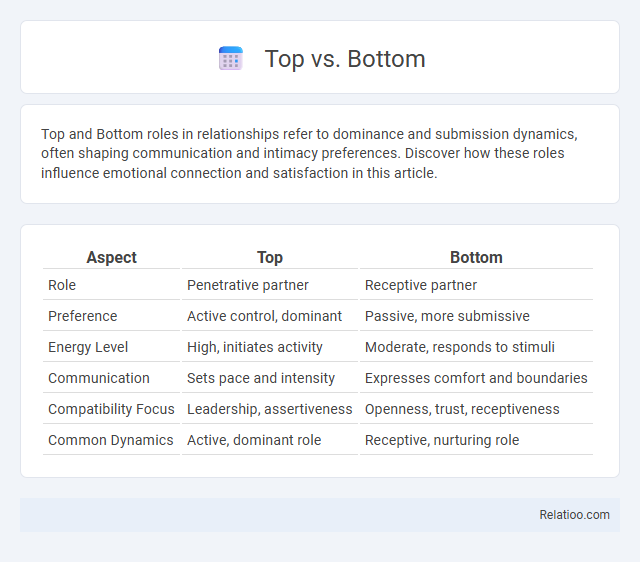Top and Bottom roles in relationships refer to dominance and submission dynamics, often shaping communication and intimacy preferences. Discover how these roles influence emotional connection and satisfaction in this article.
Table of Comparison
| Aspect | Top | Bottom |
|---|---|---|
| Role | Penetrative partner | Receptive partner |
| Preference | Active control, dominant | Passive, more submissive |
| Energy Level | High, initiates activity | Moderate, responds to stimuli |
| Communication | Sets pace and intensity | Expresses comfort and boundaries |
| Compatibility Focus | Leadership, assertiveness | Openness, trust, receptiveness |
| Common Dynamics | Active, dominant role | Receptive, nurturing role |
Introduction to Top vs Bottom
Top refers to the partner who typically takes on a more dominant or active role during intimate activities, while Bottom describes the partner who assumes a more receptive or passive position. Understanding these roles helps clarify preferences and dynamics within various sexual or kink practices. You can explore and communicate your own desires clearly by recognizing where you fit on this spectrum.
Defining "Top" and "Bottom
In BDSM terminology, a "Top" is the person who performs the action or takes control during a scene, often responsible for implementing activities like sensation play, bondage, or impact play. Conversely, a "Bottom" is the recipient of these actions, experiencing the sensations and following the Top's guidance or instructions. Understanding these roles is essential for establishing clear communication, consent, and boundaries within kink dynamics.
Historical Context of the Terms
The terms Top, Bottom, and Kink have their origins in the evolution of BDSM and queer subcultures dating back to the mid-20th century. Historically, "Top" referred to the dominant or active partner, while "Bottom" denoted the submissive or receptive individual in power-exchange dynamics, with "Kink" encompassing a broader range of non-normative sexual behaviors and preferences. These terms gained mainstream recognition through the sexual liberation movements of the 1970s and were further codified within communities like the leather scene and later the internet era, reflecting evolving understandings of consent and pleasure.
Psychological Perspectives
Top, bottom, and kink roles involve distinct psychological dynamics where power exchange, control, and vulnerability shape individual experiences. Tops often derive satisfaction from dominance and responsibility, while bottoms experience fulfillment through submission and trust, creating a complex interplay of consent and emotional safety. Your engagement in these roles can enhance self-awareness, emotional expression, and deeper connections when approached with open communication and psychological mindfulness.
Social and Cultural Implications
Top, bottom, and kink roles play crucial parts in shaping social identities and cultural narratives within LGBTQ+ communities, influencing how individuals express power dynamics and consent. These terms challenge traditional gender norms by allowing fluidity in sexual roles and promoting discussions about pleasure, boundaries, and autonomy. Embracing diverse sexual expressions fosters inclusivity and helps deconstruct stigma, enabling broader acceptance of non-normative relationships across various cultures.
Top vs Bottom in Relationships
Top and Bottom roles in relationships define distinct dynamics where the Top typically leads or takes control, and the Bottom follows or receives. Understanding these roles helps you communicate boundaries and preferences clearly, enhancing trust and satisfaction. Kink encompasses a broader spectrum of consensual activities and roles beyond the Top-Bottom dynamic, allowing for diverse expressions of intimacy.
Stereotypes and Misconceptions
Top, Bottom, and Kink roles often face stereotypes that oversimplify their complexities, such as assuming Tops are always dominant or Bottoms always submissive. Misconceptions also include the belief that kink practices are inherently unhealthy or deviant, ignoring the consensual and communicative foundations critical to these dynamics. Accurate understanding requires recognizing the fluidity and personal variation in preferences, as well as the importance of trust and negotiation in all roles.
Navigating Communication and Consent
Effective communication and explicit consent are essential when exploring Top, Bottom, and Kink dynamics to ensure all parties feel safe and respected. Clearly discussing limits, desires, and boundaries fosters trust and enhances mutual satisfaction in any BDSM or kink relationship. Employing tools like safewords and ongoing check-ins helps maintain a consensual and positive experience for everyone involved.
Evolving Attitudes and Modern Trends
Evolving attitudes toward Top, Bottom, and Kink reflects growing acceptance and exploration within diverse communities, emphasizing consent and personal expression. Modern trends highlight fluidity in roles, with individuals embracing flexibility rather than fixed labels, fostering inclusive experiences. The integration of technology and social media platforms also accelerates education and connectivity around these practices.
Conclusion and Future Perspectives
Understanding the distinctions between Top, Bottom, and Kink roles enhances the clarity of personal preferences and boundaries within consensual relationships. Your exploration of these dynamics can lead to more fulfilling interactions and deeper self-awareness. Future perspectives emphasize increasing acceptance and open communication, fostering a respectful and inclusive environment for all interests.

Infographic: Top vs Bottom
 relatioo.com
relatioo.com